1994 CHEVROLET S10 wheel
[x] Cancel search: wheelPage 146 of 340
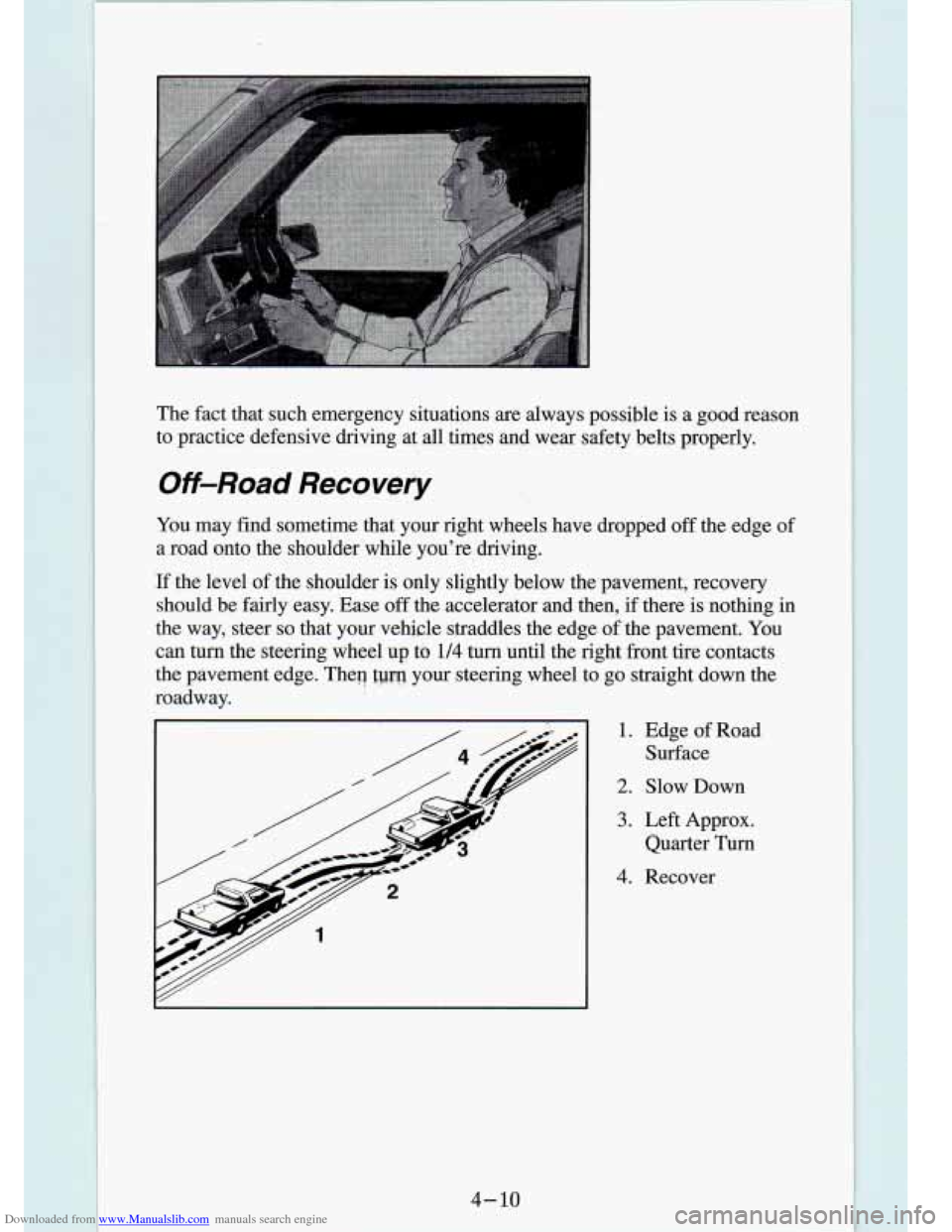
Downloaded from www.Manualslib.com manuals search engine The fact that such emergenoy situations are always possible is a good reason
to practice defensive driving at all times and wear safety bel\
ts properly.
Off-Road Recovery
You may find sometime that your right wheels have dropped off the edge\
of
a road onto the shoulder while you're driving.
If the level of the shoulder is only slightly below the pavement, recovery
should be fairly easy. Ease
off the accelerator and then, if there is nothing in
the way, steer
so that your vebcle straddles the edge of the pavement. You
can turn th'e steering wheel up
to 1/4 turn until the right front tire contacts
the pavement edge. Theq
Qgq your steering wheel to go straight down the
roadway.
1. Edge of Road
Surface
2. Slow Down
3. Left Approx.
Quarter
Turn
4. Recover
Page 148 of 340
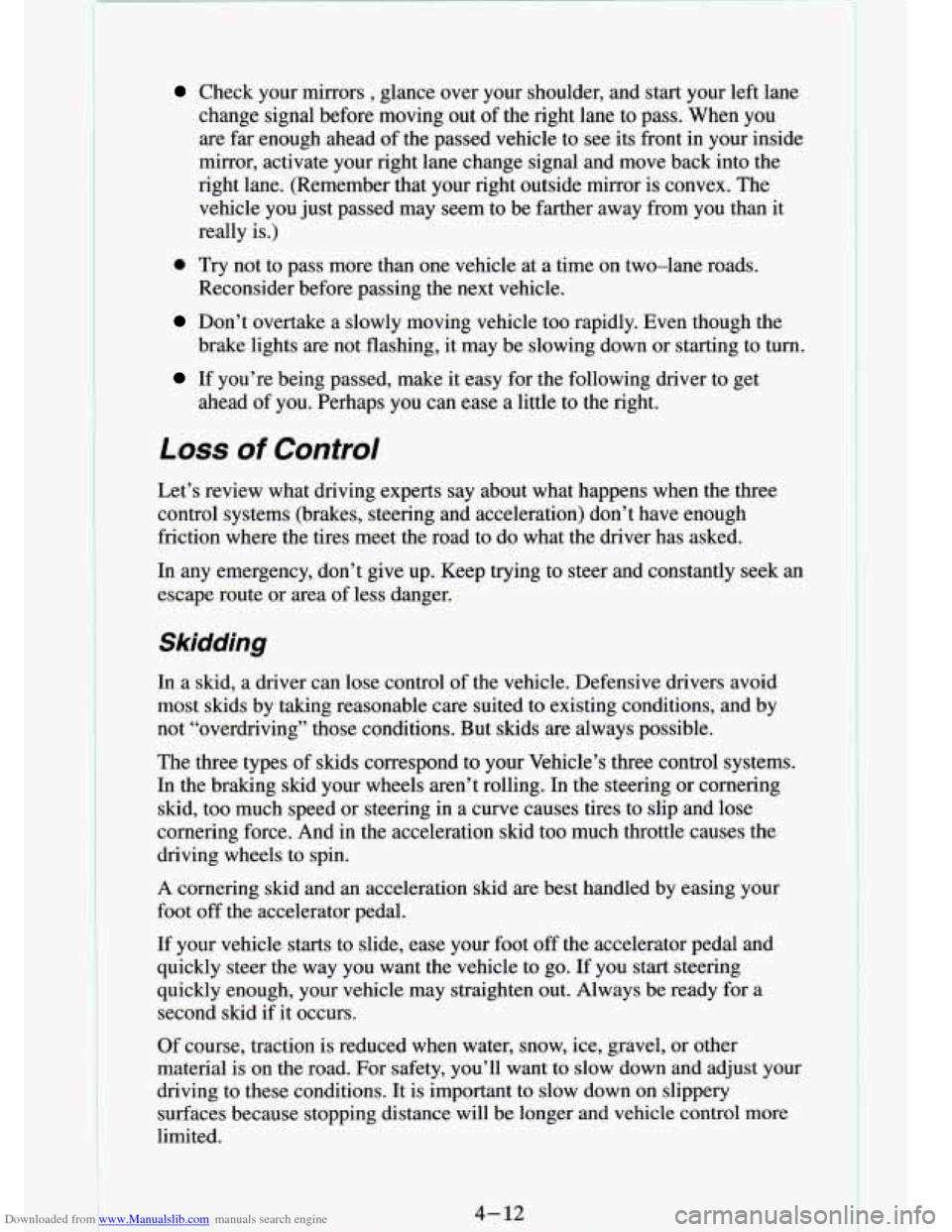
Downloaded from www.Manualslib.com manuals search engine Check your rnlrro , glance over your shoulder, and start your left lane
change signal before moving out of the right lane to pass. When you
are far enough ahead of the passed vehicle to see its front in your inside
mirror, activate your right lane change signal and move back i\
nto the
right lane. (Remember that your right outside mirror is convex\
. The
vehicle you just passed may seem to be farther away from you than it
really is.)
Reconsider before passing the next vehicle.
brake lights are not flashing, it may be slowing down or starting to turn.
ahead of you. Perhaps you can ease a little to the right.
0 Try not to pass more than one vehicle at a time on two-lane \
roads.
Don’t overtake a slowly moving vehicle too rapidly. Even tho\
ugh the
If you’re being passed, make it easy for the following driver to get
Loss of 0 mo/
Let’s review what driving experts say about what happens whe\
n the three
control systems (brakes, steering and acceleration) don’t ha\
ve enough
friction where the tires meet the road to do what the driver has asked.
In any emergency, don’t give up. Keep trying to steer and \
constantly seek
an
escape route or area of less danger.
Skidding
In a skid, a driver can lose control of the vehicle. Defensive drivers avoid
most skids by taking reasonable care suited to existing conditi\
ons, and by
not “overdriving” those conditions. But skids are always p\
ossible.
The three types of skids correspond to your Vehicle’s three control systems.
In the braking skid your wheels aren’t rolling.
In the steering or cornering
skid, too much speed or steering in a curve causes tires to slip and lose
comering force. And in the acceleration skid too much throttle causes t\
he
driving wheels to spin.
A cornering skid and an acceleration skid are best handled by easing your
foot off the accelerator pedal.
If your vehicle starts to slide, ease your foot off the accelerator pedal and
quickly steer the way you want
the vehicle to go. If you start steering
quickly enough, your vehicle may straighten out. Always be ready for a
second skid if it occurs.
Of course, traction is reduced when water, snow, ice, gravel, or other
material is
on the road. For safety, you’ll want to slow down and adjust \
your
driving to these conditions. It is important
to slow down on slippery
surfaces because stopping distance
will be longer and vehicle control more
limited.
. L.
4-12
F. ”
Page 149 of 340

Downloaded from www.Manualslib.com manuals search engine While driving on a surrace with reaucea traction, try yo best to a td
sudden steering, acceleration, or braking (including engme braki\
ng DY
shifting to a lower gear). Any sudden changes could cause the tires to slide.
You may not realize the surface is slippery until your vehicle is skidding.\
Learn to recognize warning clues
- such as enough water, ice or packed
snow on the road to make a “mirrored surface”
- and slow down when you
have any doubt.
Remember:
If you have the four-wheel anti-lock braking system, it helps
avoid only the braking skid. The rear-wheel anti-lock braking system helps
avoid only a rear braking skid. In a braking skid (where the\
front wheels are
no longer rolling), release enough pressure on the brakes to \
get the front
wheels rolling again. This restores steering control. Push the brake pedal
down steadily when you have to stop suddenly. As long as the front wheels
are rolling, you will have steering control.
Driving Guidelines
Off-Road Driving with Your Four-wheel
Drive Vehicle
This off-road guide is for vehicles that have four-wheel drive.
Also, see “Anti-lock Brakes’’
in the Index.
If your vehicle doesn’t have four-wheel drive, you shouldn’\
t drive off-road
unless you’re on a level, solid surface.
Off-road driving can be great fun. But it does have some definite hazards.
The greatest of these is the terrain itself.
“Off-roading” means you’ve left the great North American road system
behind. Traffic lanes aren’t marked. Curves aren’t banked. \
There are no
road signs. Surfaces can be slippery, rough, uphill or downhill\
. In short,
you’ve gone right back to nature.
Off-road driving involves some new skills. And that’s why it\
’s very
important that you read this guide. You’ll find many driving tips and
suggestions. These
will help make your off-road driving safer and more
enjoy able.
Before You Go Off-Roading
There are some things to do before you go out. For example, be sure to have
all necessary maintenance and service work done. Be sure
you read all the
information about your four-wheel drive vehicle in this manual. \
Is there
enough fuel?
Is the spare tire fully inflated? Are the fluid levels up where
they should be? What are the local laws that apply to off-roading where
you’ll be driving? If you don’t know, you should check with law
enforcement people in the area. Will you
be on someone’s private land? If
so, be sure to get the necessary permission.
4-13
Page 151 of 340
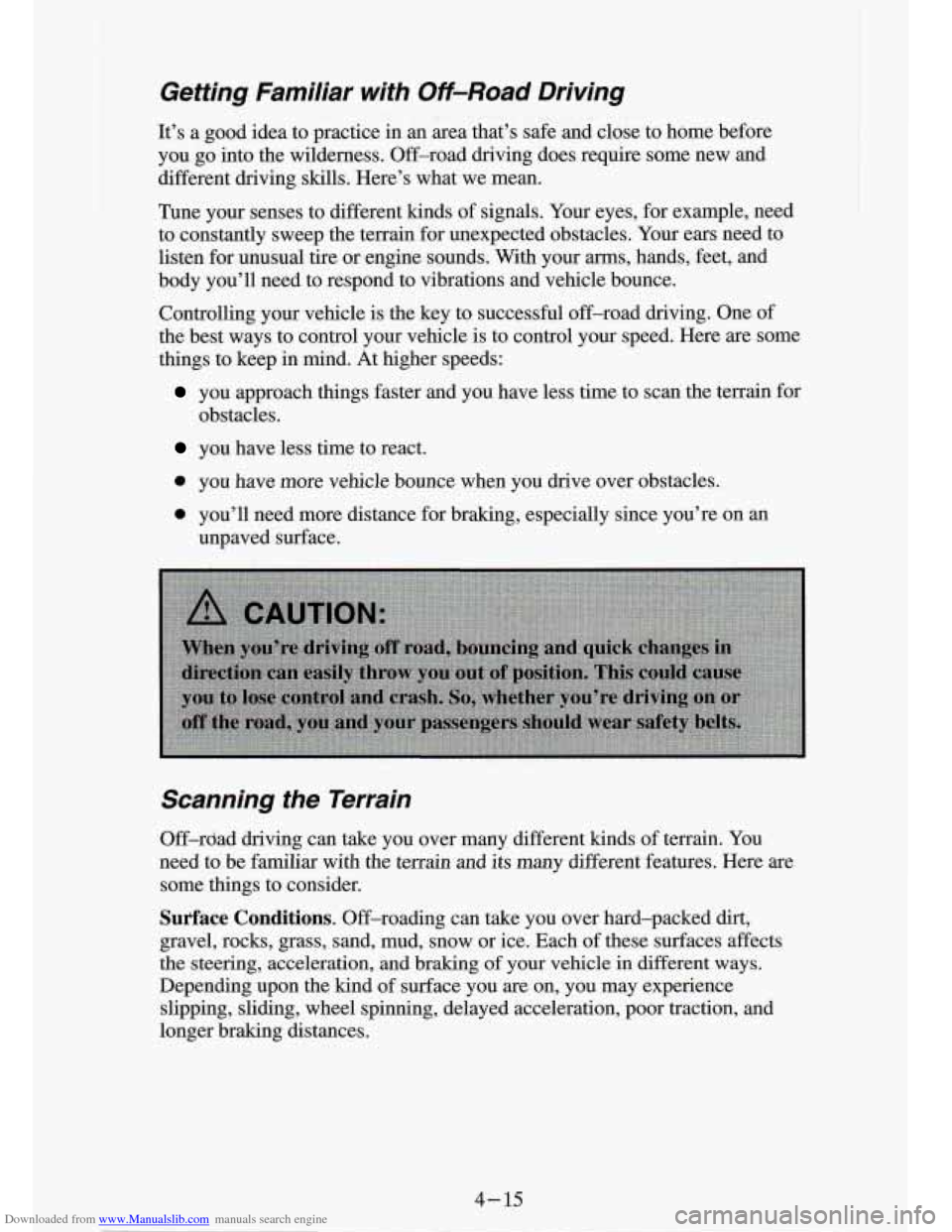
Downloaded from www.Manualslib.com manuals search engine Ge.tting Familiar with Off-Road Driving
It’s a good idea to practice in an area that’s safe and close to home befor\
e
you go into the wilderness. Off-road driving does require some new and
different driving
skills. Here’s what we mean.
Tune your senses to different kinds of signals. Your eyes, for example, need
to constantly sweep the terrain for unexpected obstacles. Your ears need to
listen for unusual tire
or engine sounds. With your arms, hands, feet, and
body you’ll need to respond to vibrations and vehicle bounce\
.
control ling^ your vehicle is the key to successful off-road driving. One of
the best ways to control your vehicle is to control your speed. Here are some
things to keep
in mind. At higher speeds:
you approach things faster and you have less time to scan the ter\
rain for
obstacles.
you have less time to react.
0 you have more vehicle bounce when you drive over obstacles.
0 you’ll need more distance for braking, especially since you’re on an
unpaved surface.
Scanning the Terrain
Off-rdad driving can take you over many different kinds of terrain. You
need to be familiar with the terrain and its many different f\
eatures. Here
are
some things to consider.
Sufface Conditions. Off-roading can take you over hard-packed dirt,
gravel, rocks, grass, sand, mud, snow or ice. Each of these surfaces affects
the steering, acceleration, and braking
of your vehicle in different ways.
Depending upon the kind
of surface you are on, you may experience
slipping, sliding, wheel spinning, delayed acceleration, poor tra\
ction, and
longer braking distances.
4- 15
Page 152 of 340
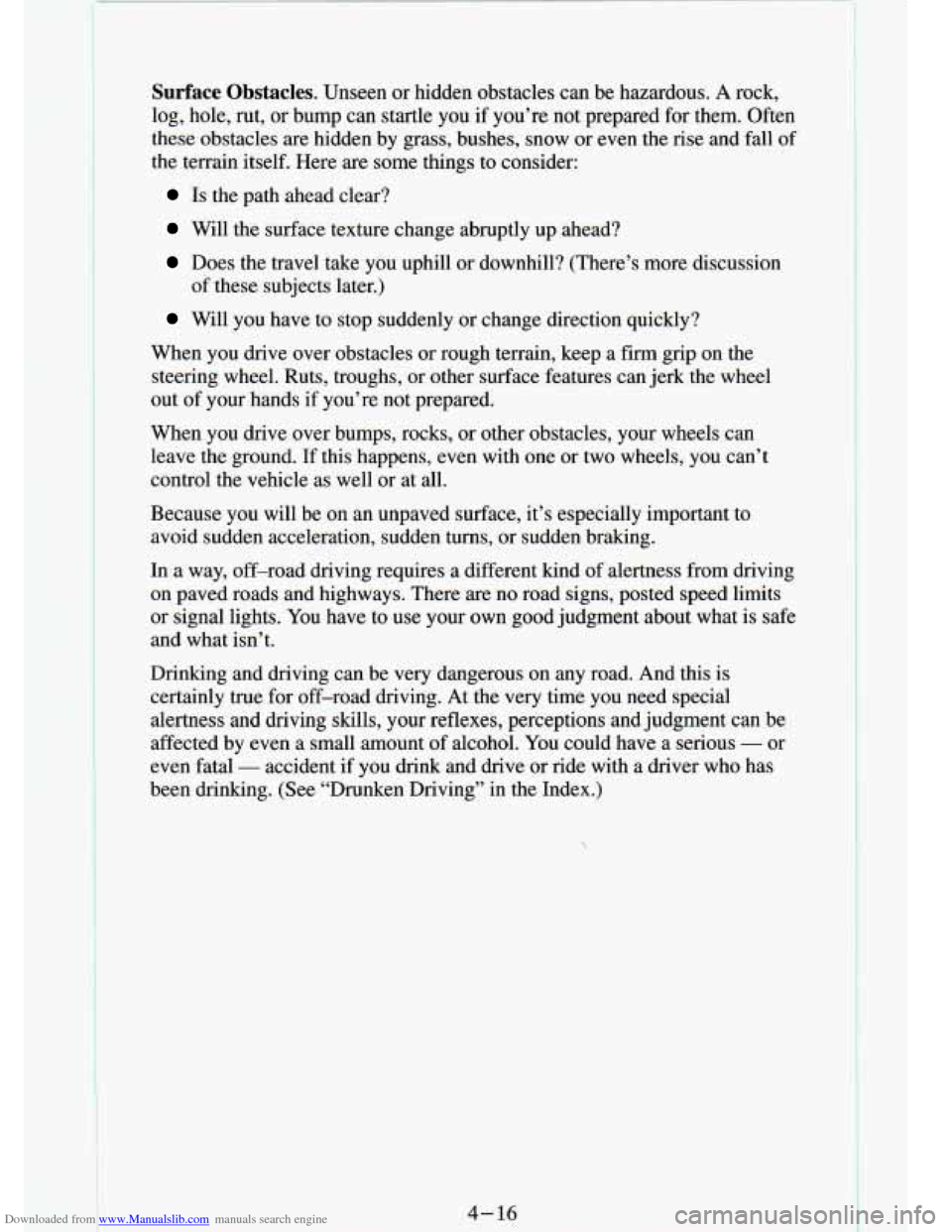
Downloaded from www.Manualslib.com manuals search engine Surface Obstacles. Unseen or hidden obstacles can be hazardous. A rock,
log, hole, rut, or bump can startle you
if you’re not prepared for them. Often
these obstacles are hidden by grass, bushes, snow or even the rise and fall of
the terrain itself. Here are some things to consider:
Is the path ahead clear?
Will the surface texture change abruptly up ahead?
Does the travel take you uphill or downhill? (There’s more \
discussion
of these subjects later.)
Will you have to stop suddenly or change direction quickly?
When you drive over obstacles or rough terrain, keep a firm g\
rip on the steering wheel. Ruts, troughs, or other surface features can jerk the wheel
out
of your hands if you’re not prepared.
When you drive over bumps, rocks, or other obstacles, your whe\
els can leave the ground.
If this happens, even with one or two wheels, you can’t
control the vehicle as well or at all.
Because you will be
on an unpaved surface, it’s especially important to
avoid sudden acceleration, sudden turns,
or sudden braking.
In a way, off-road driving requires a different kind
of alertness from driving
on paved roads and highways. There are no road signs, posted \
speed limits
or signal lights. You have to use your own good judgment about what is safe
and what isn’t.
Drinking and driving can be very dangerous on any road. And t\
his is
certainly true for off-road driving. At the very time you need special
alertness and driving skills, your reflexes, perceptions and jud\
gment can be
affected by even a small amount of alcohol. You could have a serious
- or
even fatal
- accident if you drink and drive or ride with a driver who has
been drinking. (See “Drunken Driving” in the Index.)
1
4-16.
Page 154 of 340
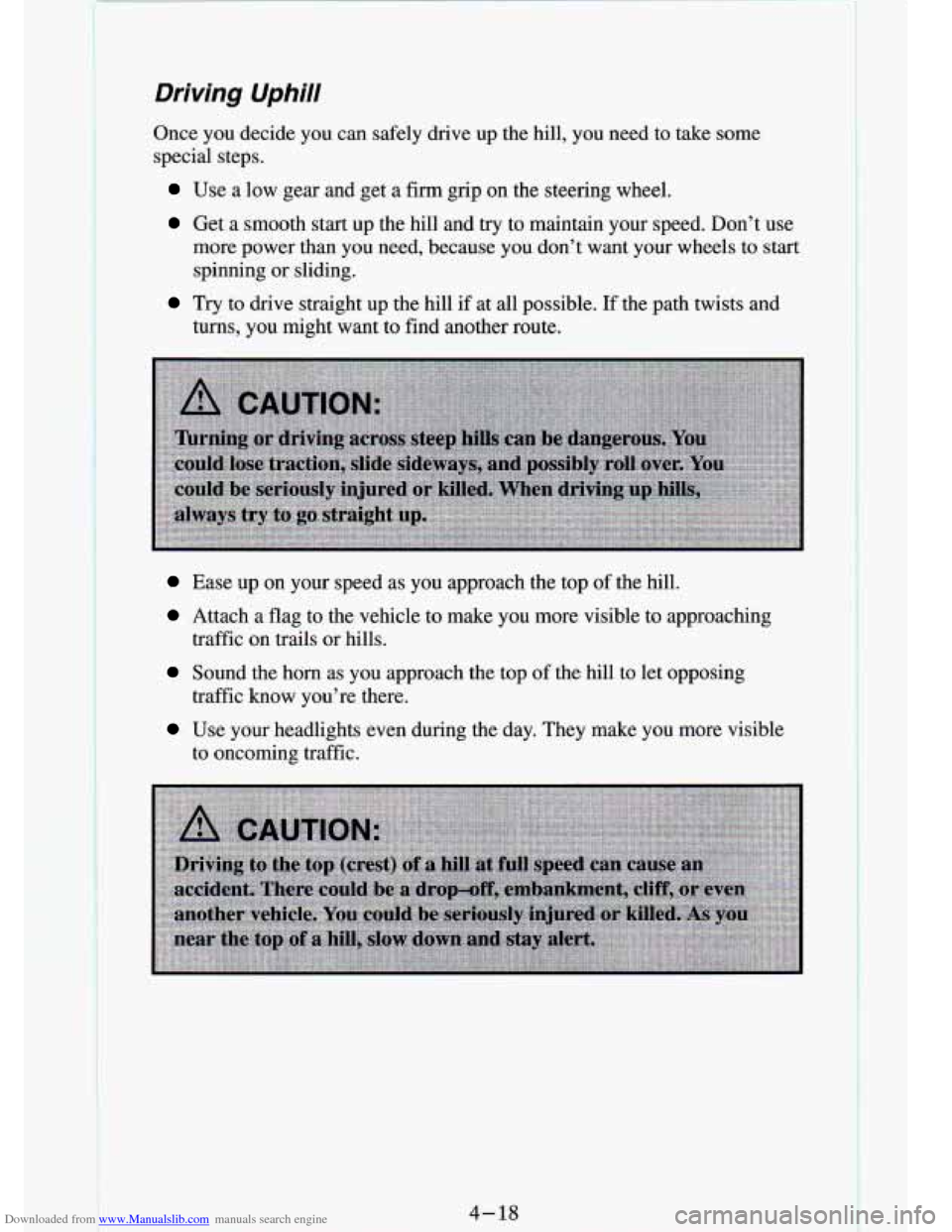
Downloaded from www.Manualslib.com manuals search engine Driving Uphill
Once you decide you can safely drive up the hill, you need t\
o take some
special steps.
Use a low gear and get a firm grip on the steering wheel.
Get a smooth start up the hill and try to maintain your spee\
d. Don’t use
more power than you need, because you don’t want your wheel\
s to start
spinning or sliding.
turns, you might want to find another route.
Try to drive straight up the hill if at all possible. If the path twists and
Ease up on your speed as you approach the top of the hill.
Attach a flag to the vehicle to make you more visible to approaching
Sound the horn as you approach the top of the hill to let opposing
traffic on trails or hills.
traffic know you’re there.
Use your headlights even during the day. They make you more v\
isible
to oncoming traffic.
..
4- 18
Page 155 of 340
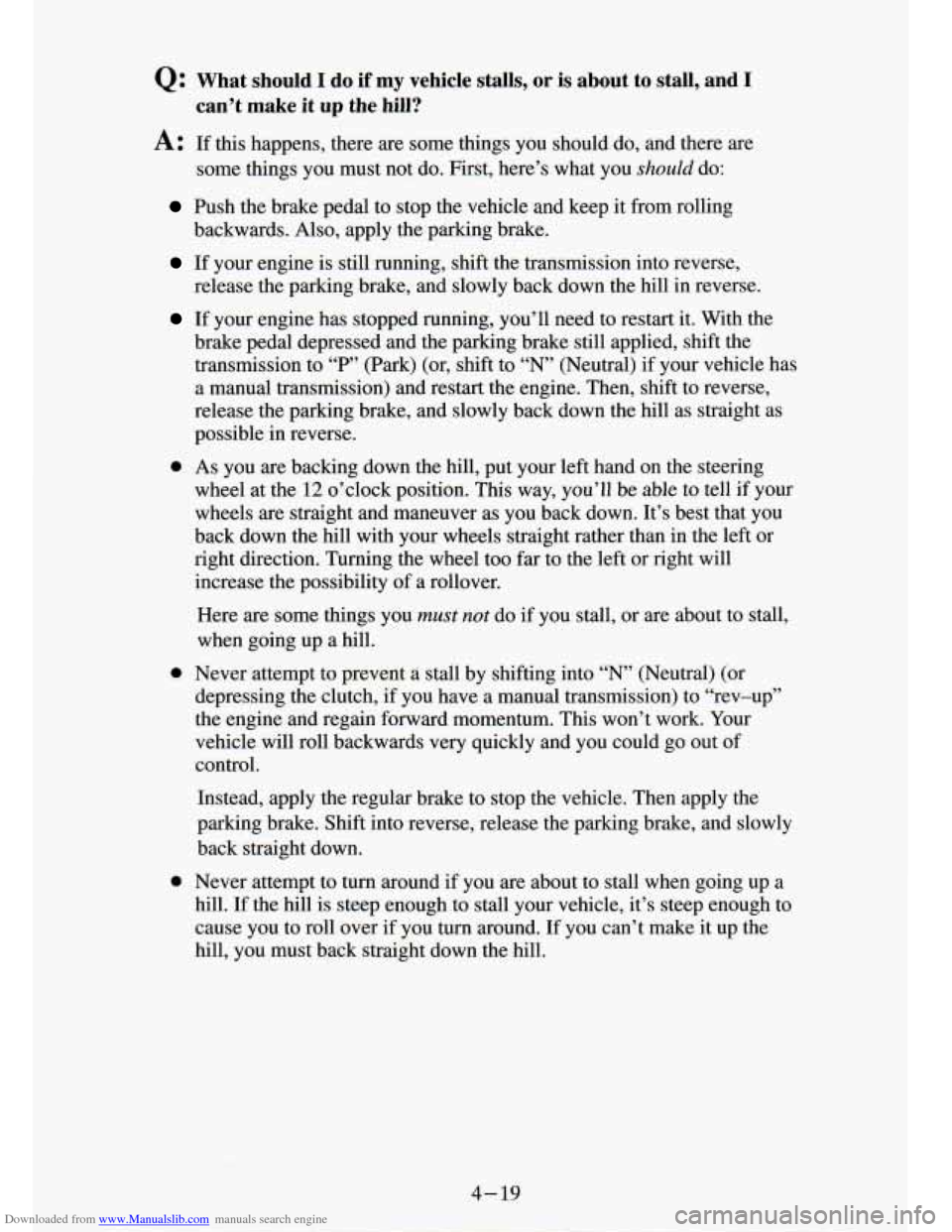
Downloaded from www.Manualslib.com manuals search engine Q: What should I do if my vehicle stalls, or is about to stall, and I
A: If this happens, there are some things you should do, and there are
some things you must not do. First, here’s what you
should do:
can’t make it up the hill?
Push the brake pedal to stop the vehicle and keep it from rolling
backwards. Also, apply
the parking brake.
If your engine is still running, shift the transmission into reverse,
release the parking brake, and slowly back down the hill in r\
everse.
If your engine has stopped running, you’ll need to restart it. With the
brake pedal depressed and the parking brake still applied, shift the
transmission to
“P” (Park) (or, shift to “N” (Neutral) if your vehicle h\
as
a manual transmission) and restart the engine. Then, shift to \
reverse,
release the parking brake, and slowly back down the hill as s\
traight
as
possible in reverse.
wheel at the
12 o’clock position. This way, you’ll be able to tell if your
wheels are straight and maneuver as you back down. It’s bes\
t that you
back down the hill with your wheels straight rather than in the left or
right direction. Turning the wheel too far to the left or right will
increase the possibility
of a rollover.
Here are some things you
must not do if you stall, or are about to stall,
when going up a hill.
0 As you are backing down the hill, put your left hand on the steering
0 Never attempt to prevent a stall by shifting into “N’ (Neutral) (or
depressing the clutch, if you have a manual transmission) to “rev-up”
the engine and regain forward momentum. This won’t work. Your
vehicle will roll backwards very quickly and you could go out \
of
control.
Instead, apply the regular brake to stop the vehicle. Then app\
ly the
parking brake. Shift into reverse, release the parking brake, and slowly
back straight down.
0 Never attempt to turn around if you are about to stall when going up a
hill.
If the hill is steep enough to stall your vehicle, it’s steep enough to
cause you to roll over
if you turn around. If you can’t make it up the
hill, you must back straight down the hill.
Page 158 of 340
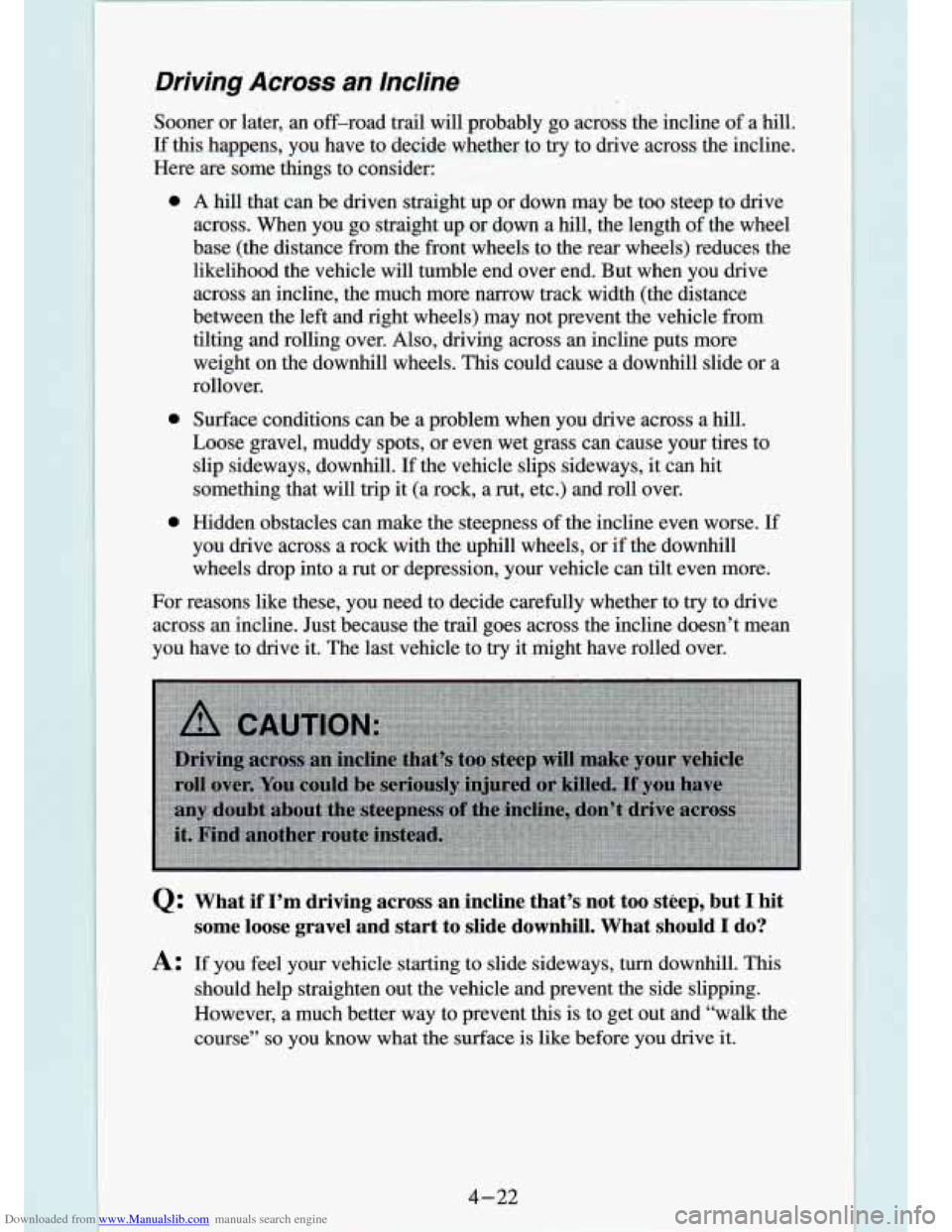
Downloaded from www.Manualslib.com manuals search engine Driving Across an Incline
Sooner or later, an off-road trail will probably go across the incline of a hill.
If this happens, you have to decide whether to try to drive across the incline.
Here are some things to consider:
(I,
0
0
A hill that can be driven straight up or down may be too steep to drive
across. When you
go straight up or down a hill, the length of the wheel
base (the distance from the front wheels to the rear wheels)\
reduces the
likelihood the vehicle will tumble end over end. But when you \
drive
across an incline, the much more nmow track width (the distance
between the left and right wheels) may not prevent the vehicl\
e from
tilting and rolling over.
Also, drivirig across an indline puts more
weight on the downhill wheels. This could cause a downhil slide or a
rollover.
Surface conditions can be
a problem when you drive across a hill.
Loose gravel, muddy spots, or even wet grass can cause your t\
ires to
slip sideways, downhill. If the vehicle slips sideways, it can hit
something that will trip it (a rock,
a rut, etc.) and roll over.
Hidden obstacles can make the steepness of the incline even worse.
I€
you drive across a rock with the uphill wheels, or if the do\
wnhill
wheels drop into a rut
or depression, your vehicle can tilt even more.
For reasons like these,
you need to decide carefully whether to try to drive
across an incline. Just because the trail goes across the incl\
ine doesn’t mean
you have to drive it. The last vehicle to
try it might have rolled over.
Q: What if I’m driving across an incline that’s not too ste\
ep, but I hit
A: If you feel your vehicle starting to slide sideways, turn downhill\
. This
should help straighten out the vehicle and prevent the side sl\
ipping.
However, a much better way to prevent
hs is to get out and “walk the
course”
so you know what the surface is like before you drive it.
some loose gravel and start to slide dowhhill. What should I do?
4-22